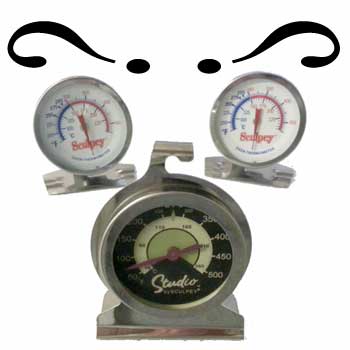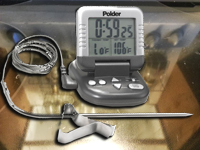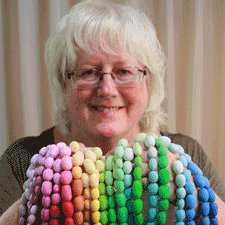Which Oven Thermometer Should You Choose
for
Baking Polymer Clay?
Oven thermometer accuracy is critical to baking polymer clay. Which is best, the oven’s controller, a separate digital probe or a standard round one?
Polymer clay is just as finicky about temperature as food is. If overcooked, oven baked clays can burn, brown, yellow, color shift and get unwanted surface changes. Once its browned you can't undo it, only cover it up or remove it. If underdone the plasticizers don’t polymerize sufficiently and the piece crumbles over time and becomes brittle.
It's actually more important to have correct temperatures while baking polymer clay. Overheated or burning polymer clay can vent toxic fumes and contaminate eating and cooking tools.
Safety Tip!
Make sure you cook your clay in a well ventilated space.
And once a kitchen tool comes in direct contact with unbaked polymer clay, don’t use it for food again.
Contrary to what you might have heard, you can safely and reliably cook polymer clay in a standard built in gas or electric oven. All you need to do is use an enclosed baking method and control the temperature. And that’s where having a good oven thermometer becomes important. But…
Built In Thermostats Are Notoriously Unreliable
Many a clayer has carefully set and double checked the oven dial only to come back an hour later to a scorched piece. Any kitchen oven, portable toaster or convection oven can be inaccurately measuring temperature. Always test your oven’s dial settings with a separate oven thermometer, or two.
Should you choose a digital probe thermometer or one of the less expensive standard round metal ones?
Metal Dial Thermometers Are Cheap
And that's their main advantage. They cost about $6, but they aren’t very accurate. I often have to use two of them to determine the true temperature of the oven, and then it’s a guess as to which one is right.
The Admetior Kitchen
is my favorite cheap one because it has a large, easily readable dial marked in both Fahrenheit and Celcius. And the temperature range only goes to 500°F. So there’s more accuracy and room between the critical temps of 200°F – 400°F. Check to make sure that they're in stock, because they're very popular.
If the Admetior is out of stock, my second best choice is the Rubbermaid Commercial FGTHO550 Stainless Steel model. Its not as popular with cooks because the temperature range isn't as wide as some others. But we don't care about high temperatures. For us, the smaller the range, the better. And this one has a larger face (2 1/8 inches on the glass) with bigger printed digits so they're easier to see inside dark toaster ovens.
There’s also a Fimo brand thermometer. They're hard to find now. The recommended temperature for curing Fimo is marked in red on the face. Unfortunately, they chose to print it in a rather small font. Unless your oven is in a very brightly lit room, it could be hard to determine if the dial pointer is in the correct place. Its also rather expensive. The last time I checked it cost more than 3 times as much as other dial types. The high price point is one good reason to check out a good digital model.
A "Studio Sculpey Clay Thermometer" used to be sold by Polyform. But it's been hard to find for quite a while and I no longer even see it on their website.
Are Digital Oven Thermometers The Best Choice?
Digital oven thermometers with a probe are more accurate and easier to read. Just place the thermal probe into the oven and close the door. They work equally well with standard built in ovens, toaster styles and convection tabletop models.
Cooking geeks like Tim Ferris in “The Four Hour Chef” recommend the Polder All in One Digital Oven Thermometer/Timer . It’s got a shelf clip, magnetic wall mounts and lots of good reviews. Polder also makes replacement probes. This polymer clayer loves it. I keep one probe for cooking food, the other’s dedicated to polyclay.
My favorite feature: The Timer! Set to alarm when your oven reaches the correct temp. Or when your baking time is up. The loud alarm goes off for 5 minutes.
My 2nd favorite feature: Memory! Create presets for Premo, Sculpey, Fimo etc. Make temperature settings for all the different types of clay you use.
My 3rd favorite feature: Long probe wires (43" inches) and the probes are cheap enough to buy two.
As Ilona from Lightpainted Doll has pointed out, the probe has to be inserted in the material that you're measuring the temperature of. You can't just measure your oven's ambient air temperature with it.
What you need to do is cut a piece of oven baking bag that's big enough to cover your probe. Put raw clay of at least 1/4 inch over the bag piece on the pointy end of the probe to make sure that the clay has reached the correct internal temperature per manufacturer's directions. If your raw clay layer is thicker than 1/4 inch try to match the thickness of the layer around the probe/oven bag. Don’t bake clay directly on the probe, you can damage it when you remove the clay.
Here’s more articles related to baking clay:
6 Tips for Baking Polymer in a Home Oven includes choosing the right temperature, how to tell when your project's done, how long to bake it, the best way to bake beads and the advantages and disadvantages of baking on glass.
What’s the best
polymer clay oven?
|
|
|
Ever burn your clay? What's your favorite oven thermometer now?
PolymerClayer Home › Thermometer Recommendations




